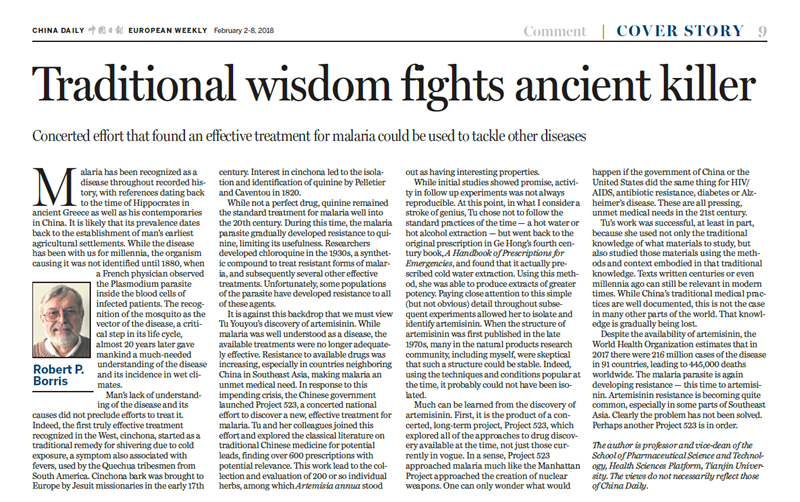Concerted effort that found an effective treatment for malaria could be used to tackle other diseases
Malaria has been recognized as a disease throughout recorded history, with references dating back to the time of Hippocrates in ancient Greece as well as his contemporaries in China. It is likely that its prevalence dates back to the establishment of man’s earliest agricultural settlements. While the disease has been with us for millennia, the organism causing it was not identified until 1880, when a French physician observed the Plasmodium parasite inside the blood cells of infected patients. The recognition of the mosquito as the vector of the disease, a critical step in its life cycle, almost 20 years later gave mankind a much needed understanding of the disease and its incidence in wet climates.

Man’s lack of understanding of the disease and its causes did not preclude efforts to treat it. Indeed, the first truly effective treatment recognized in the West, cinchona, started as a traditional remedy for shivering due to cold exposure, a symptom also associated with fevers, used by the Quechua tribesmen from South America. Cinchona bark was brought to Europe by Jesuit missionaries in the early 17th century. Interest in cinchona led to the isolation and identification of quinine by Pelletier and Caventou in 1820.
While not a perfect drug, quinine remained the standard treatment for malaria well into the 20th century. During this time, the malaria parasite gradually developed resistance to quinine, limiting its usefulness. Researchers developed chloroquine in the 1930s, a synthetic compound to treat resistant forms of malaria, and subsequently several other effective treatments. Unfortunately, some populations of the parasite have developed resistance to all of these agents.
It is against this backdrop that we must view Tu Youyou’s discovery of artemisinin. While malaria was well understood as a disease, the available treatments were no longer adequately effective. Resistance to available drugs was increasing, especially in countries neighboring China in Southeast Asia, making malaria an unmet medical need. In response to this impending crisis, the Chinese government launched Project 523, a concerted national effort to discover a new, effective treatment for malaria. Tu and her colleagues joined this effort and explored the classical literature on traditional Chinese medicine for potential leads, finding over 600 prescriptions with potential relevance. This work lead to the collection and evaluation of 200 or so individual herbs, among which Artemisia annua stood out as having interesting properties.
While initial studies showed promise, activity in follow up experiments was not always reproducible. At this point, in what I consider a stroke of genius, Tu chose not to follow the standard practices of the time - a hot water or hot alcohol extraction - but went back to the original prescription in Ge Hong’s fourth century book, A Handbook of Prescriptions for Emergencies, and found that it actually prescribed cold water extraction. Using this method, she was able to produce extracts of greater potency. Paying close attention to this simple (but not obvious) detail throughout subsequent experiments allowed her to isolate and identify artemisinin. When the structure of artemisinin was first published in the late 1970s, many in the natural products research community, including myself, were skeptical that such a structure could be stable. Indeed, using the techniques and conditions popular at the time, it probably could not have been isolated.
Much can be learned from the discovery of artemisinin. First, it is the product of a concerted, long-term project, Project 523, which explored all of the approaches to drug discovery available at the time, not just those currently in vogue. One can only wonder what would happen if the government of China or the United States did the same thing for HIV/AIDS, antibiotic resistance, diabetes or Alzheimer’s disease. These are all pressing, unmet medical needs in the 21st century.
Tu’s work was successful, at least in part, because she used not only the traditional knowledge of what materials to study, but also studied those materials using the methods and context embodied in that traditional knowledge. Texts written centuries or even millennia ago can still be relevant in modern times. While China’s traditional medical practices are well documented, this is not the case in many other parts of the world. That knowledge is gradually being lost.
Despite the availability of artemisinin, the World Health Organization estimates that in 2017 there were 216 million cases of the disease in 91 countries, leading to 445,000 deaths worldwide. The malaria parasite is again developing resistance - this time to artemisinin. Artemisinin resistance is becoming quite common, especially in some parts of Southeast Asia. Clearly the problem has not been solved. Perhaps another Project 523 is in order.
The author is professor and vice-dean of the School of Pharmaceutical Science and Technology, Health Sciences Platform.
Editor: Qin Mian






